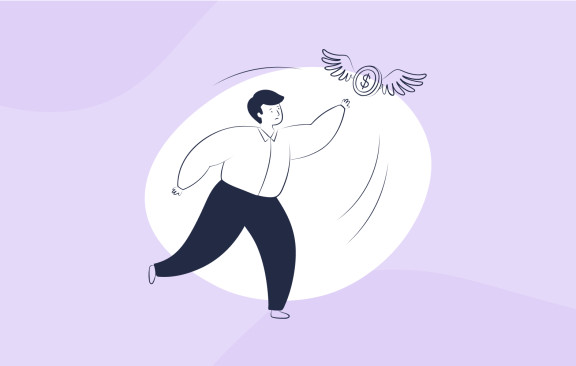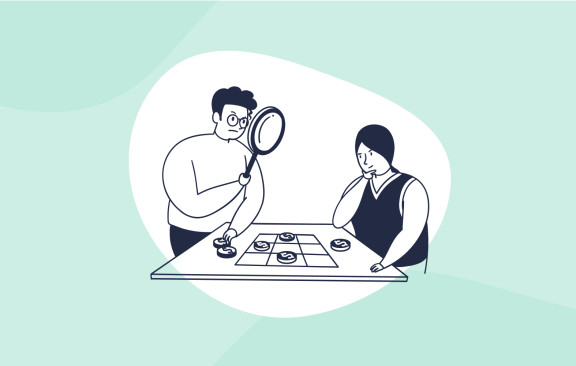Do you feel like you can’t make any money because your item is selling for the same price on Amazon or eBay?
I feel your pain.
Competition is stiff these days and it can seem like the only way to get ahead is by cutting your prices. However, I’m here to tell you: Don’t do it!
Lowering your prices to try and beat these eCommerce giants simple won’t work, and is bad for your business.
Why is competing on price bad?
Just because cutting prices may get you a few customers, doesn’t mean it’s a good strategy.
Let me tell you why:
Bargain hunters are only loyal to price
If someone bought from you due to your low prices, they’re likely to buy from someone else the minute they find a cheaper alternative.
As soon as someone undercuts you, you lose that customer.
And, trust me:
Someone will undercut you
Low pricing is a race to the bottom
Someone else will also be prepared to sell lower; it's a never-ending fight.
As soon as you undercut the competition, they’ll retaliate and undercut you. Then you go lower, then they go lower… you get my point. Unless you’re Wal-Mart or Amazon, you don’t have the money to keep up with this strategy.
Matt Remuzzi, owner of CapForge Bookkeeping, had this to say about pricing:
“If you compete on price someone will always be willing to go lower and at the same time you are ruining your chances of being able to grow your business. With tiny margins there won’t be any cash left for things like hiring, marketing or buying more equipment.”
Psychology plays a huge role
Have you ever heard the old adage, “You get what you pay for”?
It’s something deeply ingrained in to most people’s psyche. If a person sees a low-cost item, they’re likely to assume it’s low quality.
But here’s the thing:
The opposite is also true! People associate high price with high quality.
Robert Cialdini, author of "Influence: The Psychology of Persuasion", wrote a story in his book that explains this idea perfectly:
A woman ran a jewelry store whose primary market was tourists. She couldn’t sell the pieces in one particular display no matter what she did. She tried every marketing tactic in the book.
One day, before leaving for a week-long vacation, she left a quick, frustrated note telling her assistant to list the items “times 1/2” just to offload them. However, the note was written so sloppily, the assistant thought she wrote “times 2” and doubled all the prices.
You'll never believe what happened...
To the owner’s surprise, the whole case sold, but at twice the normal price! Tourists came through who didn’t know anything about gemstones and assumed “you get what you pay for” and a high price meant a high value.
Of course, I’m not saying to double your prices - but be aware of the psychological perception you’re creating with your pricing and really research your competitive analysis.
Lower pricing means less money per unit
Less money per unit, in turn, means you need to sell significantly more items to make the same profit you did before you slashed your prices.
Here’s the bottom line:
Marketing and running a business is already difficult enough when you’re making a healthy profit. Competing to be the lowest-priced retailer is simply a fool’s game and I highly encourage you not to even play.
What can you do instead?
Alternatives to competing on price (and how to implement them)
There are many ways to compete besides price.
However, at the center of almost all of them lies one fundamental word: Value.
The more value you provide to your customers, the greater the chance they will come back to you, regardless of your price.
So, what are the specific tactics you can use?
Build an amazing reputation

Becoming a reputable eCommerce store creates loyal customers and word-of-mouth marketing.
You can build a reputation as a high-end, luxury store or a mid-level vendor with practical value - it all depends on how you want to be seen.
To build a solid reputation, you must focus on:
- Providing amazing customer service. Answer people ASAP, always exceed expectations, and don’t be afraid to give discounts or freebies once in awhile to make up for a bad experience.
- Selling well-built, high-quality products. Of course, this means being very picky about who you choose as your supplier. Remember: Your suppliers are basically your business partners, so choose wisely (Read: AliExpress Alternatives).
- Shipping in excellent packaging to ensure safe delivery. If that means buying better boxes or using more bubble wrap, then so be it. There’s nothing worse than receiving a broken item or a crushed box.
- Delivering goods on time or early, every time. This is especially true if you sell items people really need, like supplements or furniture. I recently ordered a mattress off Amazon and it arrived two days later than expected - which meant two extra days sleeping on the floor. I was not happy, to say the least (Recommended reading: ePacket Shipping).
- Having an excellent refund & exchange policy. I’ll let Jay Myers (@JasonNMyers), co-founder of BoldCommerce, speak for this one. I asked him his tips on competing on things other than price, and he told me:
“Always make sure you win on your exchange and return policy. About 91% of shoppers now consider that before making a purchase, so it's an easy and obvious way to win, other than on price.”
Highlight benefits, not features
People don’t buy something because of all its fancy features. They buy because it solves a problem or helps them meet an ambition.
In other words, they buy a product because of the benefits it provides them.
People don't like buying beds - they like buying a good night's sleep.
By highlighting what’s important to the user, you’ll stand out from much of your competition, because many online sellers simply list the features out of laziness or simply not knowing this important point. That's why it's very important to do a thorough competitive analysis.
For example:
If you’re selling exercise equipment, talk about how they can help your customers build muscle, lose weight, or be healthier. If you’re selling clothes, talk about how a certain outfit will help them attract the guy or girl of their dreams, stand out at a party, or be seen as fashionable.
Offer product bundles
I love bundles. They’re an awesome way to stand out.
They work so well on Amazon because you can eliminate competition from the buy box. If no competitors offer the same bundle, when people find yours it will be the only one there! Seeing what people offer should also be a part of your competitive analysis.
For example:
If you sell a toothbrush, offer it in a bundle that includes the toothpaste, a toothbrush carrying case, a tongue scraper, floss, etc.
Bundling also works very well on eBay.
Besides your own products, Jay Myers also gave some additional insight on bundling with complementary companies:
“The second thing I suggest is to Partner up with a complimentary service or offering and pair it with your purchase. We see stores doing this and having a lot of success.
For example, if you sell kitchen supplies, offer a 1-month free subscription to some online cooking course. It's a win for them, a win for you, and something that will affect a customer's buying decision other than price.”
Think about what your products might pair well with, then look to places like Udemy to find potential courses to pair with. You can also team up with book authors, podcasters, bloggers, and anyone else with something worthwhile for your customers.
Focus on social proof

Having even just a few glowing reviews like the one above can increase conversions exponentially. According to researchers, 90% of consumers say their buying decisions are influenced by online reviews.
When it comes down to it, people want to know they’re making a good purchasing decision.
The easiest way to do that without doing extensive research or knowing someone who has, is by looking at what other shoppers already experienced from their purchase.
If you see that an item has four or even five stars across dozens or even hundreds of reviews, you can be pretty confident you’re making a good purchase decision with that product.
So, how do you get more reviews on your products?:
- Just ask. This is the simplest method. If you don’t ask, people probably won’t give them to you. Many people simply don’t have reviewing your product on the top of their mind.
- Send a follow-up email. After they’ve gotten the chance to receive and use your product, send them an email asking for a review. You may want to say something like, “If you liked this product, please give us a review. If you didn’t, please let us know why.” That way, it lessens the chance of a bad review and gives you feedback to improve the customer experience.
- Give discounts or freebies in exchange for reviews. Just be careful if you’re doing this on Amazon, as they recently banned giving away products in exchange for reviews. You can still do it, but you can’t explicitly say “We’ll give you this product in exchange for a review.” If you have your own website, then it’s no problem.
- Incentivize your reviews. Give your customers a discount or free shipping on their next purchase if they leave a review. It’s win-win: You get a review and a future purchase, and they get a discount.
In addition to reviews, user-generated content (UGC) is a great way to engage current customers and attract new ones.
UGC is any content your customers post that shows off your products.
For example:
If you sell clothing, a customer might post a picture of themselves wearing a shirt they bought from you. If you sell supplements, they might post a picture of themselves with your supplements.
One of the best ways to gather UGC is through Instagram contests.
Find new markets
If you’re selling only to buyers in your country, consider expanding to other countries. Just because prices are low where you are, doesn’t mean you can’t charge more elsewhere!
To determine if you’re ready to expand your store and how to do it, Shopify wrote this nice, easy-to-follow guide with frequently asked questions.
Use a “loss leader”
You’re on the border of competing on price with this one, but I still suggest it as a strategy in some cases because it can help you to not compete on price with other products. This will really help with your competitive analysis.
Basically, a “loss leader” is an item you take a loss on in order to get people in the (virtual) door of your store.
The idea is that people will come to your store to purchase your heavily discounted item and, while there, they also purchase complimentary items which you make a healthy profit on.
The most obvious items to promote as loss leaders are items with disposable pieces, such as razor blade handles with disposable blades or mops with disposable heads.
However, you can use almost any popular item as a loss leader as long as it has good complimentary items to pair it with.
Keep in mind you may encounter people who look specifically for stores using this tactic and will buy bulk of that item and nothing else, meaning you truly take a loss. To counter this, you can put limits on the number of sale items one person can purchase.
Additionally, this is a risky strategy because it could attract those bargain hunters who are only loyal to price, as well as turn your reputation into a “discount store” if done too often. Use this one with caution.
Related Reading: 4 Best Pricing Strategies You Can Implement Now
Utilize scarcity

Scarcity is one of the most important tactics of getting your visitors to become customers.
Scarcity could mean offering a discounted price for a limited time, only holding a limited number of products, or giving an added benefit for a limited time (like a freebie).
There is one thing I believe in when it comes to using scarcity:
Actually be true to your word. If the discounted price ends at a certain time, make it actually end at that time. This goes back to building a reputation, and also being ethical.
You can use a tool like Smar7Apps to add a product timer, among other things, to your store if you use Shopify (see also: Amazon Webstore vs. BigCommerce vs. Shopify).
Create awesome content
I’m a bit biased because it’s my area of expertise, but this is my favorite method to attracting and converting customers.
Creating content, like blog posts, podcasts, or videos, is part of a strategy called content marketing.
Basically, you create content that’s useful to your readers in the hopes they’ll read it and eventually choose you over a competitor when they decide to buy.
Some types of content you can create include:
- List posts like “The top 10 toothbrushes”.
- How-to posts like “How to brush your teeth without harming your enamel”
- Interview posts with influencers in your niche like “These 10 dentists give their take on the leading toothpaste”.
- Review posts like “Toothmaster 5000 vs. Brush-a-saurus: Which is better?”
(OK, OK - I’m done with the toothbrush analogy.)
Content works so well because people hate being interrupted by annoying ads, but love to read relevant, useful content. It solves a problem, and people are willing to pay those who solve their problems.
Also, content helps you rank higher in Google by boosting your SEO.
To sum it up all, if you only take away one thing, take this:
Competing on price is a loser’s game. Instead, compete on value.
This one simple principle can be the guiding light of your business. If you stay true to it, you’ll grow a long-lasting, worthwhile store with healthy profits. That's why it's extremely important to complete a thorough competitive analysis.
What strategies have you used to compete on besides cutting your prices? Let me know in the comments!











